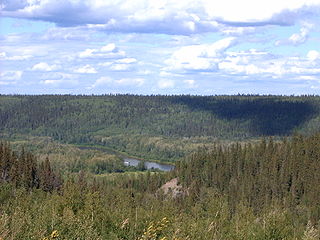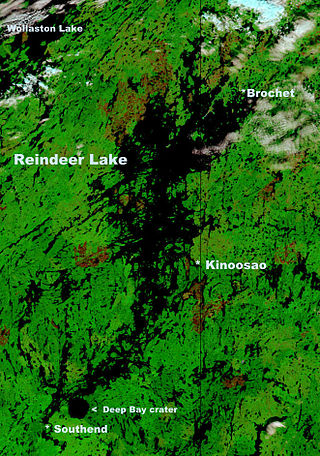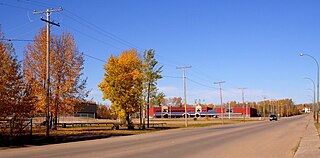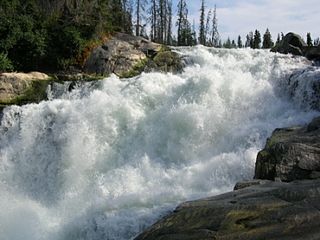
Lake Athabasca is in the north-west corner of Saskatchewan and the north-east corner of Alberta between 58° and 60° N in Canada. The lake is 26% in Alberta and 74% in Saskatchewan.

The Churchill River is a major river in Alberta, Saskatchewan and Manitoba, Canada. From the head of the Churchill Lake it is 1,609 kilometres (1,000 mi) long. It was named after John Churchill, 1st Duke of Marlborough and governor of the Hudson's Bay Company from 1685 to 1691. The Cree name for the river is Missinipi, meaning "big waters". The Denesuline name for the river is des nëdhë́, meaning "Great River".

The Clearwater River is located in the Canadian provinces of Saskatchewan and Alberta. It rises in the northern forest region of north-western Saskatchewan and joins the Athabasca River in north-eastern Alberta. It was part of an important trade route during the fur trade era and has been designated as a Canadian Heritage River.

Reindeer Lake is a large lake in Western Canada located on the border between north-eastern Saskatchewan and north-western Manitoba, with the majority in Saskatchewan. The name of the lake appears to be a translation of the Algonquian name. It is the 24th largest lake in the world by area, as well as being the second-largest lake in Saskatchewan and the ninth largest in Canada. Eight percent of the lake lies in Manitoba while 92% of the lake is in Saskatchewan.
The Methye Portage or Portage La Loche in northwestern Saskatchewan was one of the most important portages in the old fur trade route across Canada. The 19 km (12 mi) portage connected the Mackenzie River basin to rivers that ran east to the Atlantic. It was reached by Peter Pond in 1778 and abandoned in 1883 when steamboats began running on the Athabasca River with links to the railroad. It ranks with Grand Portage as one of the two most important and difficult portages used during the fur trade era.

Beaver River is a large river in east-central Alberta and central Saskatchewan, Canada. It flows east through Alberta and Saskatchewan and then turns sharply north to flow into Lac Île-à-la-Crosse on the Churchill River which flows into Hudson Bay.

Wollaston Lake is a lake in the north-eastern part of the Canadian province of Saskatchewan. It is about 550 kilometres (340 mi) north-east of Prince Albert. With a surface area of 2,286 square kilometres (883 sq mi), it is the largest bifurcation lake in the world — that is, a lake that drains naturally in two directions.

Buffalo Narrows is a northern village in Saskatchewan, Canada. It is a community of 1,110 people. Located at the "Narrows" between Peter Pond Lake and Churchill Lake, tourism and resource extraction are its main economic activities.

Canoe Lake is a lake in north-western Canadian province of Saskatchewan. Settlements on the lake include Canoe Narrows, Cole Bay, Jans Bay. The lake is accessed from Highways 965 and 903. On the western shore is a provincial recreation site called Canoe Lake Recreation Site. The Canoe River flows east from the lake to Lac Île-à-la-Crosse.

Île-à-la-Crosse is a northern village in Division No. 18, northwestern Saskatchewan, and was the site of historic trading posts first established in 1778. Île-à-la-Crosse is the second oldest community in Saskatchewan, Canada, following establishment of the Red River Colony in 1811. It sits at the end of a 20 km (12 mi) long peninsula on the western shore of Lac Île-à-la-Crosse, and is linked with Peter Pond Lake and Churchill Lake through a series of interconnected lakes, rivers, and portage routes.

Peter Pond Lake is a glacial lake in the north-western part of the Canadian province of Saskatchewan. It is located in the boreal forest and Canadian Shield within the Churchill River drainage basin.

Amisk Lake is a lake in the east-central part of the Canadian province of Saskatchewan, about 22 kilometres (14 mi) south-west of Flin Flon, Manitoba. 'Amisk' means beaver in Cree. Along the lake's shores is the community of Denare Beach, a provincial recreation site with lake access and camping, and prehistoric limestone crevices. Access to the lake and its amenities is from Highway 167. Amisk Lake was on an important fur trade route in the 18th century.
Frobisher Lake is a lake in the northern part of the Canadian province of Saskatchewan. It is situated between Turnor Lake and Churchill Lake.

Frog Portage or Portage du Traite was one of the most important portages on the voyageur route from Eastern Canada to the Mackenzie River basin. It allowed boatmen to move from the Saskatchewan River basin to the Churchill River basin. The Churchill then led west to the Mackenzie River basin. The fur trade route ran from Cumberland House, Saskatchewan north up the Sturgeon-Weir River. At its source the 300-yard Frog Portage ran, with a 20-foot drop, to Trade Lake on the Churchill a few miles west of the mouth of Reindeer River. The route then ran at least 250 miles northwest up the Churchill to Methye Portage which led to the Mackenzie basin.

Rapid River is a short river in central Saskatchewan, Canada, about 13 kilometres (8 mi) east of the community of Stanley Mission. It is part of the Churchill River drainage basin. The river is about 1,000 metres (3,281 ft) long and flows north from Iskwatikan Lake, which lies downstream from Lac la Ronge, over the Nistowiak Falls, one of the tallest in Saskatchewan, and the Fisher Rapids, to Nistowiak Lake on the Churchill River, which flows to Hudson Bay. The entire river is within Lac La Ronge Provincial Park. At the mouth of the river, on Nistowiak Lake, is the Stanley 157A Indian reserve.

Lac La Loche is a lake in north west Saskatchewan near the Alberta border. The lake is part of the Churchill River system that flows into the Hudson Bay. The La Loche River at the southern end flows into Peter Pond Lake which is connected to Churchill Lake.
Turnor Lake is a lake in northern Saskatchewan, Canada. It is part of a series of connected lakes that flow into the Churchill River drainage system. These lakes from north to south are Wasekamio Lake, Turnor Lake, Frobisher Lake and Churchill Lake. The community of Turnor Lake which includes the Birch Narrows Dene Nation is located on the southern shore of Turnor Lake. It is accessed by Highway 909 off of Highway 155
Wasekamio Lake is a glacial lake in northern part of the Canadian province of Saskatchewan. It is part of a series of connected lakes that flow south into the Churchill River drainage system. These lakes from north to south are Wasekamio Lake, Turnor Lake, Frobisher Lake, and Churchill Lake. Just north of Wasekamio Lake is the Clearwater River that flows west to the Athabasca River.

The La Loche River is a small river in north-west Saskatchewan. The distance from its source at the south east end of Lac La Loche to its mouth at the north end of Peter Pond Lake is 56 km. The river is bridged by Highway 956 about 5 kilometres from its source. The Kimowin River flows in from the west.

Lac Île-à-la-Crosse is a Y-shaped lake in the north-central region of the Canadian province of Saskatchewan along the course of the Churchill River. At the centre of the "Y" is the town of Île-à-la-Crosse, the second oldest town in Saskatchewan. Situated at the confluence of the Churchill and Beaver Rivers, the lake was an important fur trading centre in the 18th and 19th centuries. The lake, and the community of Île-à-la-Crosse, are named after the game of Lacrosse as French voyageurs had witnessed local Indians playing the game on an island in the lake.


















